Beard trimming is an essential part of male grooming, enhancing neatness, style, and confidence. A beard trimming guide tool helps achieve precise cuts and shapes, ensuring a polished look effortlessly. Using the right techniques and tools, anyone can master trimming, whether maintaining stubble or a full beard. Regular trimming prevents uneven growth and keeps facial hair healthy and well-defined, making it a cornerstone of personal style.
What is a Beard Trimming Guide Tool?
A beard trimming guide tool is an essential accessory designed to help achieve precise, even cuts during beard grooming. It typically includes adjustable guards, combs, and alignment guides to ensure symmetry and control. This tool prevents over-trimming and helps maintain consistent lengths, making it ideal for shaping cheek lines, necklines, and overall beard contours. Available in various styles, it suits different beard types and personal preferences. By using a beard trimming guide, individuals can achieve professional-looking results at home, ensuring a neat and polished appearance. It’s a versatile must-have for anyone aiming to master the art of beard grooming with ease and confidence.
Why is Beard Trimming Important?
Beard trimming is crucial for maintaining a neat, stylish, and healthy appearance. It prevents uneven growth, removes split ends, and keeps facial hair manageable. Regular trimming enhances facial definition, boosting confidence and professionalism. A well-groomed beard also reduces itchiness and dandruff, promoting skin health. Trimming allows for customization to suit face shape and personal style, ensuring a polished look. It’s a simple yet effective way to maintain hygiene, avoid irritation, and present oneself impeccably. By keeping the beard tidy, individuals can convey attention to detail and pride in their appearance, making beard trimming an essential part of daily grooming routines for many men.
Essential Tools for Beard Trimming
Essential tools for beard trimming include a beard trimmer, scissors, and a wide-tooth comb. These tools help trim, shape, and maintain a neat, styled beard effectively every time.
Beard Trimmers: Types and Features
Beard trimmers come in various types, including cordless, wired, and hybrid models, offering convenience and versatility. Key features include adjustable length settings, precision blades, and LED displays for accurate trimming. Advanced models often have ergonomic designs for better grip and control, while others include detachable guards for uniform cutting. Some trimmers are waterproof, making cleaning easier. High-quality trimmers also feature durable materials and long battery life for consistent performance. These tools cater to different beard styles, from stubble to full beards, ensuring a precise and professional finish. Choosing the right trimmer depends on personal preference, beard length, and desired grooming results.
Beard Scissors: How to Choose the Right Pair
Selecting the right beard scissors is crucial for precise trimming and shaping. Look for high-quality, sharp blades made from stainless steel or Japanese steel for durability and clean cuts. Ergonomic handles ensure comfort during use, while curved or straight edges cater to different beard styles. Scissors with adjustable tension allow for customized control, reducing fatigue. Consider the length of your beard—longer beards may require longer scissors for easier reach. To use effectively, comb out your beard first to separate hairs, then trim evenly, working from the bottom up. Proper scissors maintain neatness and prevent split ends, ensuring a polished look. Regular sharpening keeps them in optimal condition.
Beard Combs: Their Role in Trimming
Beard combs are indispensable tools in the trimming process, serving both practical and styling purposes. They help detangle hair, preventing knots that can lead to uneven cuts. By brushing the beard, combs lift hairs, making it easier to identify split ends and stray strands. Wide-tooth combs are ideal for thicker, longer beards, while fine-tooth combs work best for shorter styles. Combs also guide scissors or trimmers, ensuring precise cuts and maintaining symmetry. Regular use promotes healthy growth by distributing natural oils and reducing breakage. A good comb enhances the trimming experience, making it smoother and more effective, leading to a neater, more defined beard shape. Proper combing is the foundation of successful trimming.
A Step-by-Step Guide to Trimming Your Beard
Start with clean, brushed beard. Choose tools like trimmers or scissors. Trim evenly, defining edges. Adjust length and shape precisely. Finish with neat lines and a polished look. Mastering these steps ensures a professional result every time, keeping your beard tidy and stylish. Regular maintenance is key to maintaining your desired style and preventing uneven growth. Follow these simple steps for a well-groomed beard that enhances your facial features and personal style.
Preparation: Washing and Brushing Your Beard
Proper preparation is key to successful beard trimming. Start by washing your beard with a mild shampoo to remove dirt and oil. Rinse thoroughly and pat dry with a clean towel, avoiding rubbing to prevent damage. Next, brush your beard to detangle and align the hairs, ensuring an even trim. Use a wide-tooth comb or a beard brush for this step. Brushing helps identify uneven areas and makes trimming more precise. A clean and brushed beard allows for better visibility and control during the trimming process, ensuring a neat and professional-looking result. This step is crucial for achieving the best outcomes.
Choosing the Right Tools for Your Beard Type
Selecting the right tools for your beard type is crucial for effective trimming. For shorter beards, consider a precision trimmer or razors, while longer beards may require scissors or trimmers with adjustable length guards. A beard trimmer with multiple attachments is ideal for varying beard styles. If you have a patchy beard, opt for a trimmer with a detail comb to maintain evenness. For full, thick beards, high-quality scissors or a powerful trimmer with long guards are recommended. Always match your tool to your beard’s thickness and length for a clean, professional finish. Using the wrong tool can lead to uneven results or damage to your beard.
Trimming Techniques: Length and Shape
Mastering trimming techniques involves balancing length and shape to enhance your beard’s appearance. Start by trimming in small increments, using longer guard sizes first to avoid over-trimming. For a natural look, follow the grain and taper at the cheeks and neck. To define shape, use a trimmer without a guard for clean lines, or scissors for precision. Always brush your beard downward to see uneven areas clearly. Use a mirror to ensure symmetry and blend edges smoothly for a polished finish. Adjusting length and shape carefully ensures a beard that complements your face shape and personal style effectively.
Finishing Touches: Edging and Cleaning Up
Finishing touches are crucial for a polished beard look. Use a trimmer or razor to create clean lines along the neckline and cheekbones, ensuring a defined edge. For a natural blend, taper the edges where the beard meets the skin. Clean up stray hairs around the ears and mouth for a neat appearance. Apply a hot towel to soften hairs before edging for precision. Lightly brush the beard to spot any stray hairs and trim them carefully. Avoid over-trimming, as it can disrupt the beard’s shape. Finally, use a comb or brush to blend edges smoothly, ensuring a seamless transition between trimmed and natural areas for a professional finish.
Maintaining Your Beard Shape
Daily grooming, regular trims, and precise edging are essential for keeping your beard well-defined. Use trimmers and razors to maintain clean lines and desired length, ensuring a polished look.
Daily Maintenance Tips
Daily beard maintenance ensures a neat and stylish appearance. Start by washing your beard with a mild shampoo and conditioner, then pat dry to avoid damage. Use a beard brush or comb to detangle and align hairs, promoting even growth. Regularly trim stray hairs with scissors or a trimmer to maintain shape and length. Pay attention to the neckline and cheek line, keeping them defined. Apply beard oil or balm to keep hair soft and skin moisturized. For longer beards, consider using a leave-in conditioner. Consistency is key—set aside a few minutes each day to groom and adjust as needed for a polished, healthy-looking beard.
Shaping the Cheek Line and Neckline
Shaping the cheek line and neckline is crucial for a defined beard look. The cheek line runs from the sideburn to the mustache, while the neckline frames the jaw. Use a trimmer or razor to create clean edges. For the cheek line, place the trimmer at the natural boundary where the beard meets the cheek and trim downward. For the neckline, outline just above the Adam’s apple and follow the jawline. Always trim with the grain to avoid irritation. Regular touch-ups keep these areas neat. A guide tool or comb can help achieve precise lines. Maintaining these boundaries enhances facial symmetry and ensures a polished beard appearance. Consistency is key for a sharp, well-groomed look.
Styling Different Beard Lengths
Styling different beard lengths requires tailored techniques to enhance facial features and personal style. For stubble, maintain a short, even look using a trimmer with a short guard. Medium-length beards benefit from blending techniques to create a seamless transition between the beard and neckline. Full beards demand precise shaping to avoid bulkiness, often achieved with scissors and a comb for detail. A beard trimming guide tool helps achieve uniformity and symmetry, ensuring the beard complements the face shape. Regular touch-ups and proper tool usage are essential for maintaining any beard length. Balancing the style with facial contours ensures a polished, professional appearance. Consistent grooming keeps the beard healthy and stylish.
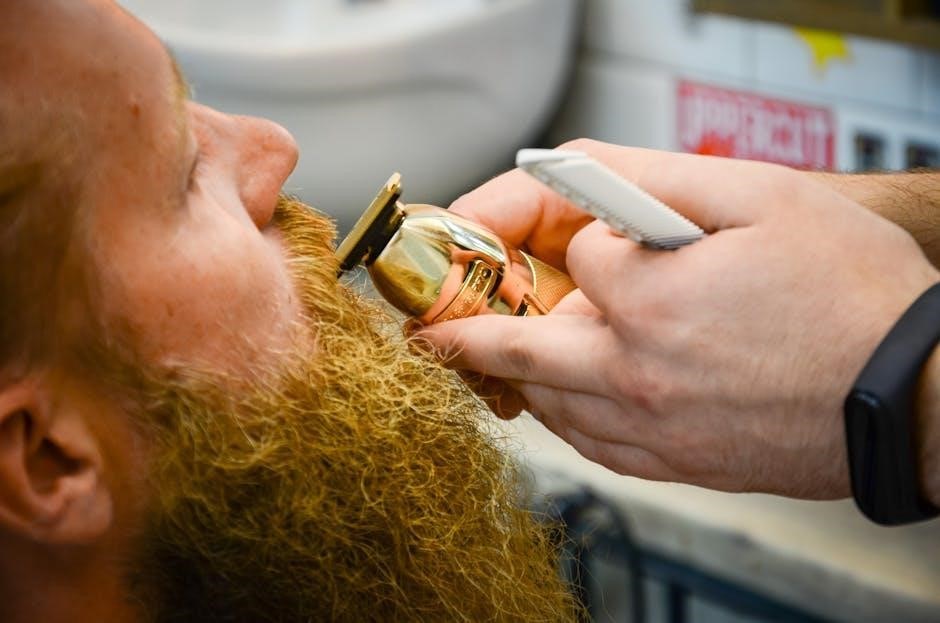
Common Mistakes to Avoid
Over-trimming is a frequent error, leading to uneven results. Trimming wet hair can cause unexpected shortness, as it appears longer than it actually is when dry. Always use guards on trimmers to maintain desired lengths and avoid cutting too much in one pass. Patience and precision are key to achieving a balanced look without ruining the beard’s shape.
Over-Trimming and How to Fix It
Over-trimming is a common mistake that can leave your beard looking uneven or patchy. To avoid this, use a trimmer with guards to maintain consistent lengths. If you’ve over-trimmed, don’t panic. Start by identifying the areas where the beard is too short. Use clippers without the guard to blend the uneven parts with the rest of the beard. For minor fixes, trimmers with adjustable settings can help match lengths. If the damage is significant, consider growing the beard a bit longer to allow for an even trim. Patience and careful touch-ups are key to restoring your beard’s natural look.
Uneven Trimming: Causes and Solutions
Uneven trimming often occurs due to improper technique or using the wrong tools. To avoid this, always use a beard trimming guide tool to ensure symmetry and consistency. Start by combing your beard to identify longer hairs, then trim in small, controlled strokes. If unevenness occurs, use a trimmer without the guard to carefully blend the areas. For severe cases, grow the beard slightly longer to allow for an even cut. Regular maintenance and patience are essential to achieving a balanced look. Using the right tools and techniques will help you master even trimming and keep your beard looking its best.
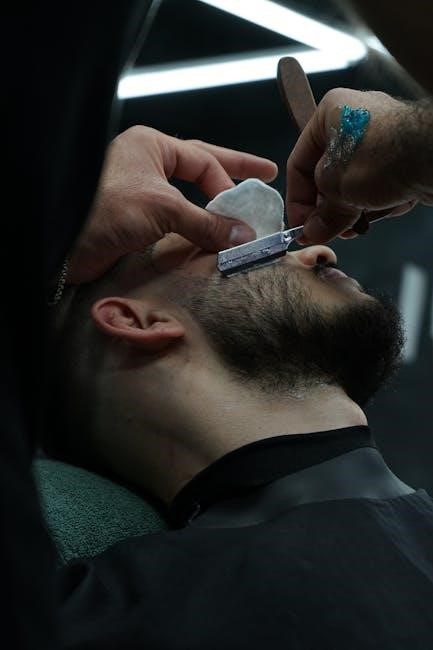
Advanced Beard Trimming Techniques
Advanced beard trimming involves expertise in precision techniques, using trimmers and guide tools for tapering, fading, and crafting defined edges for a polished, professional look.
Creating a Defined Edge
Creating a defined edge is crucial for a polished beard look. Start by identifying the natural boundary between your beard and skin, typically along the cheek and neckline. Use a trimmer without the guard attachment for a close cut, brushing your beard beforehand to visualize the shape. To maintain precision, pull the skin taut and trim in small, controlled strokes, following the natural curve of your jawline. For extra sharpness, consider using a razor, but with caution to avoid nicks. Regular touch-ups every few days will keep the edge looking neat. Practice patience and consistency to master this technique, enhancing your beard’s overall appearance with a clean, defined edge.
Trimming for Specific Beard Styles
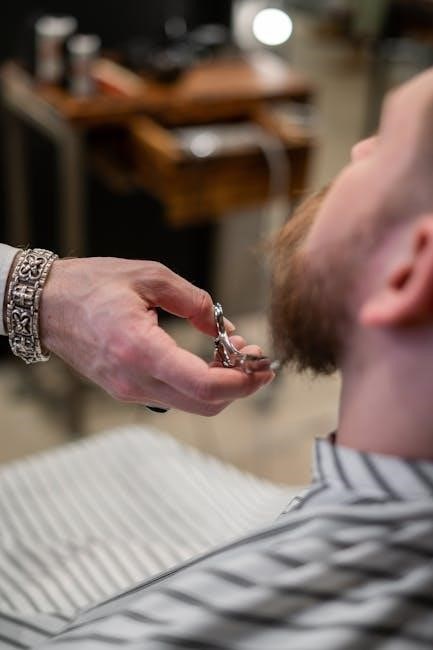
Trimming your beard to match specific styles requires precision and the right tools. For a stubble look, use a trimmer with a short guard to maintain even length. Achieving an Idris Elba-coded stubble involves trimming close to the skin but not too deep to avoid unevenness. For a goatee, focus on shaping the chin and mustache area, ensuring symmetry. When growing a full beard, regular trims prevent scraggly ends while maintaining volume. Each style demands a tailored approach, so choose the appropriate guard sizes and techniques to achieve your desired look. Regular maintenance and attention to detail are key to keeping your beard styled perfectly according to your chosen aesthetic.
Using Trimmer Guards Effectively
Trimmer guards are essential for achieving consistent lengths and protecting your skin from cuts. Start with a longer guard for bulk trimming, then switch to shorter ones for detail work. Always pull the skin taut to ensure an even cut. For precise edges, use a guard with a built-in comb to guide the trimmer. Replace worn guards to maintain performance. Using the right guard size helps prevent over-trimming and ensures your beard looks neat and styled. Regularly cleaning and storing guards prolongs their lifespan. Experiment with different guard lengths to find what works best for your beard style and maintenance routine. This technique ensures professional-looking results at home.

Product Reviews and Recommendations
Quality beard trimming tools are crucial for a polished look. Top-rated trimmers offer adjustable lengths, precision blades, and ergonomic designs. Famous brands ensure durability and style, making them worth the investment.
Top Beard Trimmers on the Market
When it comes to beard trimming, investing in a high-quality trimmer is essential. The King C. Gillette Beard Trimmer is a top choice, offering precision and adjustable settings for any length; Other standout options include the Wahl Beard Trimmer, known for its durability and advanced features, and the Philips Norelco Multigroomer, which provides versatile grooming for both beard and body hair. These trimmers are praised for their ease of use, cordless operation, and sleek designs. Many models come with LED displays and multiple attachments, ensuring a customized trim every time. Whether you prefer a clean look or a rugged style, these trimmers deliver professional results at home.
Best Beard Scissors for Precise Trimming
For precise beard trimming, high-quality scissors are indispensable. Look for sharp, stainless steel blades that ensure clean cuts without splitting hairs. Curved scissors are ideal for shaping and detailing, while straight scissors work best for longer beards. Ergonomic handles enhance comfort during use. Top-rated options include the Utopia Care Beard Scissors and the Sanguine Beard Trimming Scissors, both praised for their durability and precision. When using scissors, comb your beard first to separate hairs, then cut carefully for a polished look. Regular cleaning and proper storage will extend their lifespan, making them a valuable addition to your grooming toolkit.
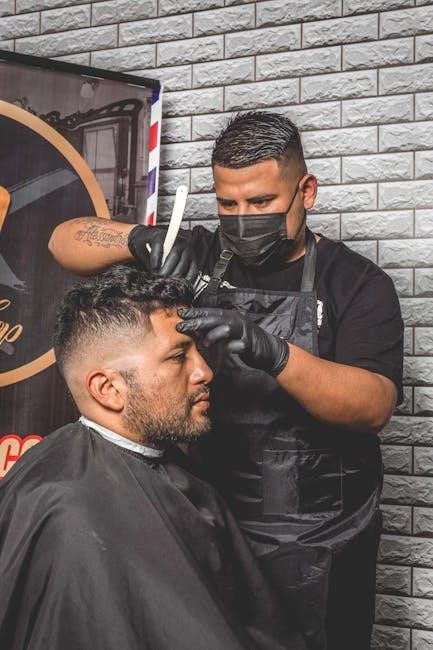
Additional Tips and Tricks
For a professional finish, use a hot towel to soften beard hair before trimming. Brush against the grain to identify uneven areas and trim in small increments for accuracy. Combining these techniques ensures a neat, polished look, enhancing your beard’s natural style and texture while maintaining hygiene and definition. Regular maintenance is key to keeping your beard healthy and well-groomed. Always pat dry after washing to avoid damage and style with confidence.
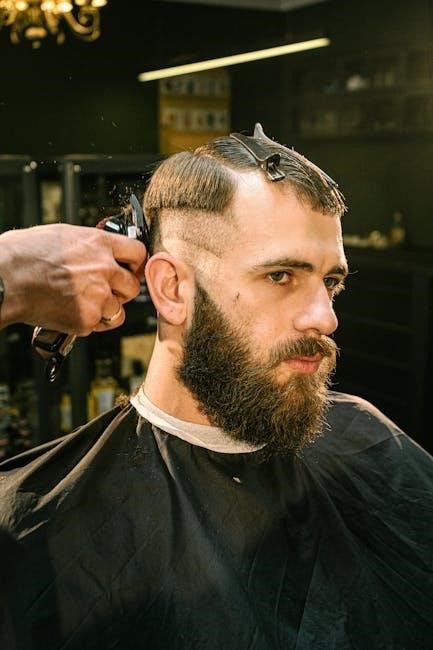
How to Trim Your Beard at Home Like a Pro
Trimming your beard at home can achieve salon-quality results with the right techniques. Start by washing and drying your beard to prevent tangles. Use a beard brush to detangle and define the shape. Choose the right tools, such as sharp scissors or a trimmer with adjustable guards, to maintain even length. Trim in small increments, working from the bottom up, and use a mirror for visibility. For precise edges, shave or use a trimmer without a guard. Finally, clean up stray hairs and apply a beard oil to keep your beard healthy and shiny. Regular practice makes perfect, ensuring a professional finish every time.

Mastering beard trimming enhances your style and confidence. With the right tools and techniques, achieving a polished look is effortless. Regular maintenance ensures healthy growth and defined edges, making it a simple yet impactful part of your grooming routine.
Final Thoughts on Beard Trimming
Beard trimming is a skill that enhances both style and confidence. With the right tools and techniques, achieving a well-groomed beard becomes effortless. Consistency is key to maintaining shape and health, while patience allows for mastering the process. Whether using scissors, trimmers, or combs, understanding your beard’s unique needs ensures a polished look. Avoid common mistakes like over-trimming, and embrace the journey of shaping your facial hair. Remember, trimming is personal, so take your time and enjoy the transformation. A neatly trimmed beard not only boosts aesthetics but also reflects dedication to self-care and personal style.
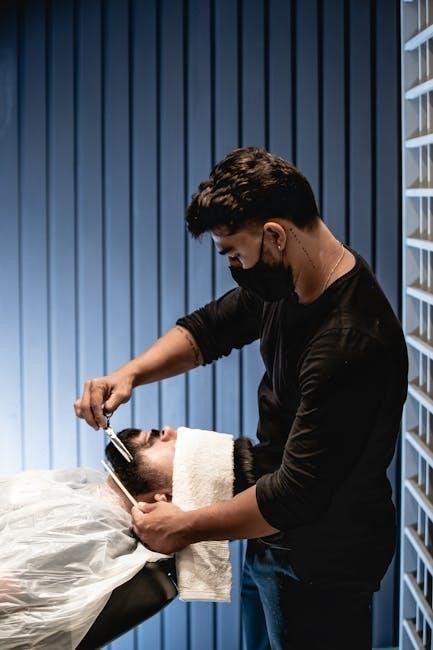
Additional Resources
Explore expert articles, videos, and guides from trusted sources like Beardbrand and YouTube for in-depth beard trimming tutorials and tool recommendations to refine your grooming skills.
Recommended Articles and Videos
For further learning, check out “How to Trim Your Beard at Home Like a Pro” by Beardbrand, offering detailed steps and tips. Watch “Ultimate Beard Trimming Guide” on YouTube for visual tutorials. Articles like “10 Easy Steps to Shape Your Beard” provide photos and guides, while “Beard Trimming Mistakes to Avoid” helps refine your technique. Videos from professional barbers, such as Dom Holt’s Trimming Tips, showcase expert methods. These resources cover tools, techniques, and maintenance, ensuring you master beard trimming and achieve your desired style with confidence.

Frequently Asked Questions
- What tools are best for trimming a beard?
- How often should I trim my beard?
- Can I fix an uneven trim?
- How do I choose the right trimmer guard size?
Common Queries About Beard Trimming
Many wonder about the best tools for trimming, with beard trimmers and scissors being top choices. Others ask how often to trim, which depends on growth rate and style. Fixing uneven trims is another concern, often addressed by using mirrors and touch-ups. Choosing the right guard size is crucial for desired lengths. Questions also arise about maintaining shape and preventing mistakes. Experts recommend starting with clean, dry beards and using proper techniques. These queries highlight the importance of guidance, making beard trimming guides invaluable for achieving a polished look. Addressing these concerns ensures a successful trimming experience for all beard enthusiasts.
